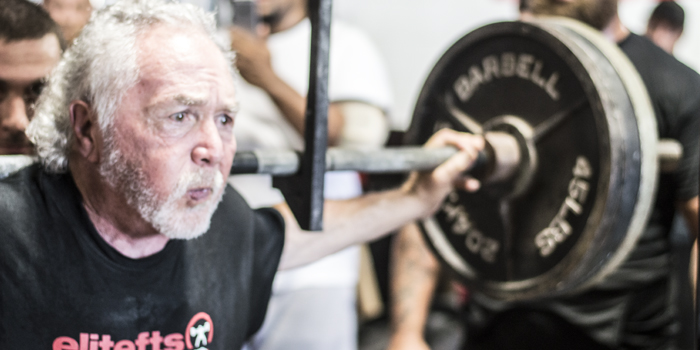
Thank you to everyone who read my article last month and especially those who made such kind and supporting comments. In that article, I decried the lack of resistance training by seniors, the absolute benefits thereof, and the necessity, therefore.
But I'm not finished yet. I am still upset and have a few more points to make in my sermon, or rant, as the case may be. I am still upset by the fact that the perception of the public, especially senior members of the public, is that:
- We have to slow down as we get older and should not engage in such strenuous activities as lifting weights — especially heavy weights.
- After a serious illness or surgery, we as seniors must reduce activity to avoid a similar situation.
Just the other day I talked to a friend who I had not seen since my heart surgery. He said to me, "I trust you're not still lifting heavy weights. You had better not be." I explained to him that not only was I still lifting, but that I set a lifetime squat PR just last week. His attitude is all too common in our society. This man's attitude is too prevalent, notwithstanding he was an outstanding college athlete and had a pro football tryout.
RECENT: Preaching to the Choir: Seniors and Strength Training
There is a heart surgeon who tries to dispel this myth. He requires his patients to sign a contract before surgery. The contract says that, after surgery, patients will undertake a physical feat greater than what they had done before, such as climb a mountain or run a marathon. Shorty after my heart surgery, my sister, who is five years younger, had both her knees replaced at the same time. I made a deal with her that within a year she had to complete a 10K, walk, run or stumble. In exchange, I had to lift more weight than I had ever lifted.
We both succeeded in performing our respective feats.
What can we do to change this public perception? What can we do to get our seniors off their collective ass and into the gym for resistance training? The medical community is no real help. It seems to me that they are satisfied if their patients walk on a treadmill. And the treadmill seems to be the most popular device in most commercial gyms. It's good that seniors come to the gym, and walking on a treadmill is better than nothing. It will not, however, improve muscularity or bone density — the things seniors need the most, especially women.
It wouldn't hurt my feelings if there were a gym with no treadmills. And that is exactly what exists in the gym where I train and where I train others.
Those seniors who do venture into the machine area or free weight area of commercial gyms often don't know what the hell they are doing. So, if a novice senior watches you train, let them! Answer any questions they might have and offer help if they'll accept it. Many can't afford to hire a personal trainer and can get hurt not knowing what they are doing. It is a pet peeve of mine concerning commercial gyms. It is my considered opinion that the gym staff should personally instruct every member in the first 30 days of membership on how to use every machine and free weight apparatus.
There is some mainstream support for the propositions that I advocate. The American College of Sports Medicine encourages resistance training two to three times a week for seniors. The Wall Street Journal recently published an article "Benefits of Pumping Iron in Later Life." In it, they discussed the case of a retired 75-year-old surgeon who could hardly walk from being hunched over from years of performing surgery. Resistance training straightened out his life. Now he plays golf and regularly walks as much as six miles.
To illustrate some of my points, let me tell you about a few case studies. These are not scientific studies, as I would not even know how to do one. These are observations of mine that prove a point that I truly believe is valid. These case studies are of real people that I know and have observed, whose names are fictitious.
Tim and Tom were high school classmates many years ago. Both were very good athletes. Tim was a six-foot-three, left-handed, outstanding basketball player. Tom was a stocky center and middle linebacker. They both played baseball, Tim at first base and Tom at third. Neither was good enough to be a scholarship athlete at UNC, where they both attended college. Both played some sports as adults. At age 68 they both had hip replacements a month apart, Tim in December and Tom in January.
Tom worked hard at his rehab, walking and exercising. When he was able, he began lifting weights on a regular basis. Tim did his rehab, but when he finished with the physical therapist, he was finished. They saw each other at their 50th high school reunion the following September. Tim was there walking with a cane, still nursing the hip. Tom was there walking well and getting ready for his first powerlifting meet in March of the following year. Passion, determination, and work ethic seem to have been the difference.
Jim and John were also friends and both were very good athletes. John played college football on a scholarship and Jim was a very versatile athlete in many sports — none good enough to merit a college scholarship. Both were very good tennis players and golfers. John, at age 80, had a heart that required a stint be placed in one of his arteries. Both participated and completed a course of cardiac rehab.
John worked hard in cardio rehab to regain confidence that he was well or soon would be. Jim did what was required in cardiac rehab and had difficulty regaining the confidence that he could be better than before the stint. After cardiac rehab, John began a regimen of resistance training with compound movements as his main exercise. John is getting stronger and stronger, lifting heavier and heavier weights. He walks and plays golf. His confidence is great and he's going hard.
Jim never regained the confidence he sought. He has led a guarded life with some walking, very little golf, no resistance training, and no weights. John may live forever. Jim, in my opinion, is living with the clock ticking. How much longer the clock keeps ticking remains to be seen.
While there is some change in mainstream thinking, it's not reaching those who need it. I think the medical community must intervene, but it's doubtful that will happen. Their opinion often carries more weight than ours as trainers. This "walking on a treadmill" bullshit has to stop. We need to pick up some weights. And let us all say AMEN!











I look forward to your articles, and always gain knowledge and inspiration from them. Seeing you nail that squat was also inspiring, and it's wonderful to see you in action! I'm repeating myself, but I would love to see a training log from you on this site, or anywhere else. Now that I've made it to 70 and I continue to train, it would be great to see what my fellow lifters in our age group are doing in terms of training. You probably don't need any more on your plate though. Best wishes for good health, continued success and thank you.
Joe
Some of my liver enzymes were up so I now try to workout lighter but as intense as i can so that i don't have to take as much ibuprofen of best of all none. Recently i've also had problems with my scalenes neck muscle and neck stiffness, with often very sore traps.
Been trying to foam roll and flexing the spine in the thoracic area along with other things like stretching. Its nice to set a new PR but its also good maybe better to continue to workout in an intense manner so as to invoke growth hormone if that is even possible but i do think it is witness the younger appearance that comes with proper training.
So while i am not going to try for new PR's i will continue to work as effectively as i can.
One thing is certain I always feel better after a workout.